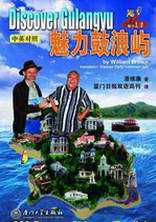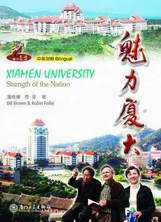![]() Click
to
Access
Click
to
Access
AMOY MAGIC SITE from
OUTSIDE China
![]() Click
to Access Amoy
Magic Site from
Click
to Access Amoy
Magic Site from
INSIDE
China ![]()
TRAVEL
LINKS
![]() Xiamen
Xiamen
![]() Gulangyu
Gulangyu
![]() Jimei
Jimei
![]() Tong'an
Tong'an
![]() Jinmen
Jinmen
![]() Zhangzhou
Zhangzhou
![]() Quanzhou
Quanzhou
![]() Wuyi
Wuyi
![]() #1Fujian
Sites!
#1Fujian
Sites!
![]() Fujian
Foto Album
Fujian
Foto Album
![]() Books
on Fujian
Books
on Fujian
![]() Readers'Letters
Readers'Letters
![]() Ningde
Ningde
![]() Zhouning
Zhouning
![]() Longyan
Longyan
![]() Sanming
Sanming
![]() Putian
Putian
![]() Bridges
Bridges
![]() Travel
Info,
Travel
Info,
![]() Hakka
Roundhouses
Hakka
Roundhouses
![]() Travel
Agents
Travel
Agents
MISC. LINKS
![]() Amoy
People!
Amoy
People! ![]()
![]() Darwin
Driving
Darwin
Driving ![]()
![]() Amoy
Tigers
Amoy
Tigers
![]() Chinese
Inventions
Chinese
Inventions
![]() Tibet
in 80 Days
Tibet
in 80 Days![]()
![]() Amoy
Vampires!
Amoy
Vampires!
![]() Dethroned!
Dethroned!
![]()
![]() Misc.Writings
Misc.Writings
![]() Latest
News
Latest
News
![]() Lord
of Opium
Lord
of Opium
![]() Back
to Main Page
Back
to Main Page
Copyright 2001-8 by Sue Brown & Dr.
Bill ![]() Order
Books
Order
Books
Note:
Please click thumbnails
for larger photos!!
![]() Amoy
Hill's Photos
Amoy
Hill's Photos![]()
![]() ger
pics)
ger
pics)
![]() Jehovah
Nissi Christian Bookstore
Jehovah
Nissi Christian Bookstore ![]() Trinity
Church Website (Gulangyu)
Trinity
Church Website (Gulangyu) ![]() Directory
of Xiamen's 40+ churches
Directory
of Xiamen's 40+ churches ![]() XICF
XICF
![]() Bamboo
Church Website (great photos)
Bamboo
Church Website (great photos) ![]() Xiamen
YMCA & YWCA
Xiamen
YMCA & YWCA ![]()
![]() Click
for Bio of Jessie Johnston, Missionary to Amoy
(1885-1904)
Click
for Bio of Jessie Johnston, Missionary to Amoy
(1885-1904)
![]() Click
for Biography of Caldwell Family (Fujian missionaries, 1899 to 1949)
Click
for Biography of Caldwell Family (Fujian missionaries, 1899 to 1949)
![]() Click
for "Life of Christ by Chinese Artists!" (1940)
Click
for "Life of Christ by Chinese Artists!" (1940)
![]() Click
Here for "City of Springs" (about
Quanzhou, in 1902)
Click
Here for "City of Springs" (about
Quanzhou, in 1902)
![]() China
Studies Program
China
Studies Program![]() Rev.
John Sung
Rev.
John Sung

Judges
in the 2002 Livcom competition
in Germany, home of the Reformation, were surprised when I told them that
Xiamen was the "Birthplace of Chinese
Protestantism. David Abeel started
the Amoy Mission, and Xiamen's New
Street Chapel (нÖÀñ°ÝÌã©, built in 1848, was China's first Protestant
church. But S. Fujian has a very long tradition of religious diversity
and tolerance. ..
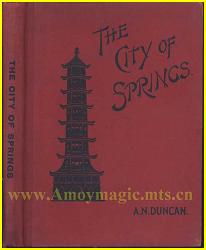 Let
me give you a brief overview of S. Fujian's
phenomenal international religious heritage, and then I'll finish
with the more recent history (1840s onward) of Chinese protestantism in
S. Fujian.
Let
me give you a brief overview of S. Fujian's
phenomenal international religious heritage, and then I'll finish
with the more recent history (1840s onward) of Chinese protestantism in
S. Fujian.
Note: for the best insight
on Fujian's amazing contributions to global seafaring, commerce, and cultural
and religious exchange, visit Quanzhou's UNESCO-sponsored Maritime Museum!
The
Alexandria of Asia!
1,000 years ago, S. Fujian was the start
of the Maritime Silk Road--the southern gateway to China, from which Chinese
sailed all over the known world. It was also the destination of diplomats,
merchants and missionaries from all over the world. The almost mythical
port of Quanzhou (of which Xiamen was
a part) was called Zaytun by the Arabs, who claimed that it was the port
of call for even legendary heroes like Sinbad the Sailor! The largest
port in the world, rivaling Alexandria, Egypt, Marco Polo said that for
every shipload of pepper sailing to Christendom, 100 ships or more sailed
to Quanzhou! But S. Fujian was also a great center for religion and philosophy.
Back to top
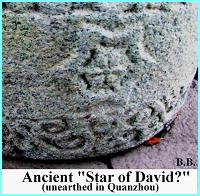
 The
Jerusalem of Asia! S. Fujian hosted every known religion, from
Nestorian Christianity, Tibetan Buddhism, and Hinduism, to Franciscan
Catholicism, Jainism and Judaism. Hindus had at least one temple, largely
because of close ties with Tamil traders (you can even see parts of the
Hindu temple that were used to rebuild Kaiyuan Temple). Even today, Quanzhou
has the only remaining temple to Manichaeanism (the Persian religion that
St. Augustine followed for a decade until he became a saint and wrote
a best-selling set of tracts against the religion of "light and dark").
And if the legends are true, Quanzhou has what must be one of the oldest
Islamic communities on the planet.
The
Jerusalem of Asia! S. Fujian hosted every known religion, from
Nestorian Christianity, Tibetan Buddhism, and Hinduism, to Franciscan
Catholicism, Jainism and Judaism. Hindus had at least one temple, largely
because of close ties with Tamil traders (you can even see parts of the
Hindu temple that were used to rebuild Kaiyuan Temple). Even today, Quanzhou
has the only remaining temple to Manichaeanism (the Persian religion that
St. Augustine followed for a decade until he became a saint and wrote
a best-selling set of tracts against the religion of "light and dark").
And if the legends are true, Quanzhou has what must be one of the oldest
Islamic communities on the planet.
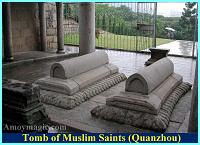 Mohammed,
facing persecution at home, sent disciples abroad. Of the 4 who came to
China, one went to Guangzhou, one to Yangzhou, and two to Quanzhou. 1,000
years ago, Quanzhou had 40,000 Muslims, and at least 7 Mosques (only the
Ashab Mosque, circa 1008 A.D., remains today). The Muslims, of course,
were the master traders, merchants and adventurers of the ancient world,
and many rose to high levels in the provincial government. The two tombs
to the right, on "Spirit Hill" in the east of Quanzhou City,
are said to contain the remains of Mohammed's disciples. Whether true
or not, the spindle-shaped granite columns show the tombs date to at least
the Tang Dynasty 1000 years ago, and historical records show that the
great Muslim Chinese admiral, Zhenghe, paid homage to the tombs.
Mohammed,
facing persecution at home, sent disciples abroad. Of the 4 who came to
China, one went to Guangzhou, one to Yangzhou, and two to Quanzhou. 1,000
years ago, Quanzhou had 40,000 Muslims, and at least 7 Mosques (only the
Ashab Mosque, circa 1008 A.D., remains today). The Muslims, of course,
were the master traders, merchants and adventurers of the ancient world,
and many rose to high levels in the provincial government. The two tombs
to the right, on "Spirit Hill" in the east of Quanzhou City,
are said to contain the remains of Mohammed's disciples. Whether true
or not, the spindle-shaped granite columns show the tombs date to at least
the Tang Dynasty 1000 years ago, and historical records show that the
great Muslim Chinese admiral, Zhenghe, paid homage to the tombs.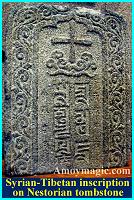
 Nestorian
Christians
were right on the Muslim's heels. Alopen, a Persian Bishop, started the
first Nestorian work in China's capital of Chang'an in 635 A.D., and in
638 he finished his first Chinese work, "The Sutra of Jesus the Messiah.
Shortly afterwards, Quanzhou was also a major center for these amazing
people who were 1,000 years ahead of their time--at least in terms of
missionary strategy.
Nestorian
Christians
were right on the Muslim's heels. Alopen, a Persian Bishop, started the
first Nestorian work in China's capital of Chang'an in 635 A.D., and in
638 he finished his first Chinese work, "The Sutra of Jesus the Messiah.
Shortly afterwards, Quanzhou was also a major center for these amazing
people who were 1,000 years ahead of their time--at least in terms of
missionary strategy.
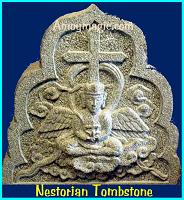 Doctors
& Surgeons Like missionaries of the 1800s, many Nestorians
were doctors and skilled surgeons, and welcomed wherever they went for
their healing skills. In addition, they set up language schools, where
they not only learned local languages but also translated the Bible into
the various tongues. (Click Here to see how
they translated some ideas!) They were also politically savvy!
Doctors
& Surgeons Like missionaries of the 1800s, many Nestorians
were doctors and skilled surgeons, and welcomed wherever they went for
their healing skills. In addition, they set up language schools, where
they not only learned local languages but also translated the Bible into
the various tongues. (Click Here to see how
they translated some ideas!) They were also politically savvy! 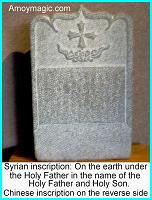
Alopen's first Chinese work was careful to point out that the Christian
faith had nothing that was subversive or contrary to China's traditions,
and that in fact Christians emphasized both filial piety and loyalty to
the state. He went so far as to paint Emperor Tai Cong's portrait on the
walls of the Nestorian church (just as Byzantine monks painted Emperor
Justinian's portrait on the walls of the church in Ravenna). The emperor
was evidently impressed, because he decreed that Alopen be known as Spiritual
Lord, Protector of the Empire, and ordered a Nestorian monastery built
in the extreme west of the city.
While the Nestorian stele (which you can see in Xi'an today!) may have
exagerrated somewhat, they claimed the faith was throughout China, and
monasteries were in hundreds of Chinese cities, and we know that Bishop
Gabriel arrived in Canton by at least 713 A.D., and worked with Persian
merchants. When Nestorians reached Quanzhou I'm not sure, but the large
number of Nestorian relics unearthed there suggests it was quite early,
and they may have survived to the day of Marco Polo, who wrote of Hangzhou's
beautiful Nestorian church (which was built in 1281 by Mar Sargis, of
Samarkand, whom Kublai Khan had appointed as governor of what is now Jiangsu).
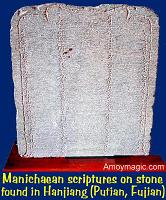 The
Religion of Light!
Nestorians, who were laregly from Persia, were influenced by another Persian
religion--Manichaeanism. This religion flourished throughout China--at
least until the Emperor banned the "Religion of Light" (called
Ming Jiao) for having the same name as the new dynasty, Ming (ironic,
because the Manichaeans helped put the new Ming emperor in power--but
it at least proves the Chinese' early concern with intellectual property
rights). The Manichean religion taught that reality was an eternal battle
between the powers of light and darkness, and that we mortals were just
the battleground. St. Augustine followed this religion for a decade because
he saw this war in himself. He often partied by night, and prayed by day,
"O Lord, give me chastity--but ot yet!" He left the religion
of light after the death of his illegitimate teenage son, became a Catholic
Bishop, and eventually even a saint. Whether he ever achieved chastity
is not clear.
The
Religion of Light!
Nestorians, who were laregly from Persia, were influenced by another Persian
religion--Manichaeanism. This religion flourished throughout China--at
least until the Emperor banned the "Religion of Light" (called
Ming Jiao) for having the same name as the new dynasty, Ming (ironic,
because the Manichaeans helped put the new Ming emperor in power--but
it at least proves the Chinese' early concern with intellectual property
rights). The Manichean religion taught that reality was an eternal battle
between the powers of light and darkness, and that we mortals were just
the battleground. St. Augustine followed this religion for a decade because
he saw this war in himself. He often partied by night, and prayed by day,
"O Lord, give me chastity--but ot yet!" He left the religion
of light after the death of his illegitimate teenage son, became a Catholic
Bishop, and eventually even a saint. Whether he ever achieved chastity
is not clear.
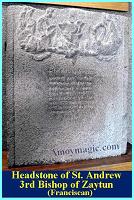 Franciscan
Catholics were in Quanzhou within a century of St. Francis'
death, and
Franciscan
Catholics were in Quanzhou within a century of St. Francis'
death, and the city has at least 3 Catholic cathedrals. The Emperor not only welcomed
these foreign faiths but actually subsidized them! For an amazing account
of the emperor's openmindedness and generosity, read the letter home written
by St. Andrew of Perugia, 3rd Bishop of Zaytun (in Mystic
Quanzhou--City of Light--or click here to read Bishop
Andrew's letter online).
the city has at least 3 Catholic cathedrals. The Emperor not only welcomed
these foreign faiths but actually subsidized them! For an amazing account
of the emperor's openmindedness and generosity, read the letter home written
by St. Andrew of Perugia, 3rd Bishop of Zaytun (in Mystic
Quanzhou--City of Light--or click here to read Bishop
Andrew's letter online).
After
China closed her doors, most foreign religions largely disappeared, except
for Islam and Buddhism (which, contrary to popular belief, is also imported).
The Catholics did maintain isolated outposts throughout Fujian, but had
little impact until the Opium Wars. 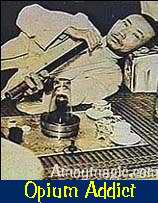
Opium
Opens Amoy
The West hungered for Chinese silk, tea and porcelain, but had a problem
paying for it because it had little that China wanted or needed--except
silver! To help balance their trade deficit, Western countries smuggled
opium into China. China, not the U.S., started the first "Just Say
No!" to drugs campaign, but Britain (backed by France, the U.S. and
other Western powers) countered with a "Just Say Yes!" campaign,
and fought two Opium Wars to make their
point. Read my brief overview of the Opium Wars, and I suspect that, like
me, you'll feel both shame and relief (relief that the Chinese are a forgiving
people!).
Back to top
5 Treaty Ports After China was defeated
in the first Opium War, she agreed to open 5 ports to foreign "trade"
(ironically, the treaty never mentioned the word "opium"). The
treaty also gave missionaries access to these 5 ports, two of which were
in Fujian (Fuzhou and Amoy). 
 Some
people claim that missionaries came with the Bible in one hand and opium
in the other. That's not exactly true. What is true, unfortunately, is
that the missionaries did come in on opium ships, and often had close
relations with opium dealers, whose ships provided much-needed supplies.
So in Chinese eyes, missionaries and opium dealers were cut from the same
cloth--though in fact many missionaries fought fiercely against the opium
trafficking, and set up hospitals and schools to help heal and educate
the
Some
people claim that missionaries came with the Bible in one hand and opium
in the other. That's not exactly true. What is true, unfortunately, is
that the missionaries did come in on opium ships, and often had close
relations with opium dealers, whose ships provided much-needed supplies.
So in Chinese eyes, missionaries and opium dealers were cut from the same
cloth--though in fact many missionaries fought fiercely against the opium
trafficking, and set up hospitals and schools to help heal and educate
the  Chinese.
It should also be noted that most Westerners, by far, opposed the opium
trade. In fact, the entire British parliament opposed the 2nd Opium War!
The prime minister simply dissolved parliament and went to war anyway.
By the 1920s, fully half of Western profits in Asia derived from opium!
Britain did not give up its opium monopoly in Hong Kong until 1945, when
the embarrassment outweighed the benefit.
Chinese.
It should also be noted that most Westerners, by far, opposed the opium
trade. In fact, the entire British parliament opposed the 2nd Opium War!
The prime minister simply dissolved parliament and went to war anyway.
By the 1920s, fully half of Western profits in Asia derived from opium!
Britain did not give up its opium monopoly in Hong Kong until 1945, when
the embarrassment outweighed the benefit.
Why
S. Fujian?
Only a few months ago did I learn why missionaries converged upon S. Fujian!
When China was closed to Christianity, missionaries went to other S.E.
Asian countries. Most of these countries had overseas Chinese, most of
whom came from S. Fujian and spoke the Minnan dialect (same as Taiwan
dialect). So the missionaries learned Minnan, and when China opened up,
they quite naturally went to the people with whom they could communicate--the
Southern Fujianese! ...Click
Here to see how the Rev. Carstairs Douglas
literally worked himself into the grave over the Amoy Dialect! David Abeel
done himself in as well.
Back to top
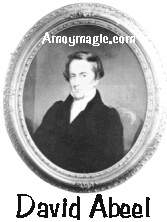 David
Abeel, Amoy's 1st missionary, started the Amoy Mission in 1842,
but our beautiful little island did a number on him as well and he returned
home in 1845 and died in 1846. (No wonder Xiamen was called the "White
man's graveyard!) Click Here for more about David
Abeel.
David
Abeel, Amoy's 1st missionary, started the Amoy Mission in 1842,
but our beautiful little island did a number on him as well and he returned
home in 1845 and died in 1846. (No wonder Xiamen was called the "White
man's graveyard!) Click Here for more about David
Abeel.
Protestants started several churches on Amoy and Gulangyu Islands. Catholics were busy too. The Vicariate Apostolic of Amoy (created in 1883 under the ominicans) oversaw 11 European and 8 Chinese priests, 32 churches or chapels, 3 orphanages, and 13 schools (and included Taiwan in its domain). The piano played an integral part in all religious services-and Gulangyu folk have been hooked on them ever since. So missionaries came with the bible in one hand and pianos, not opium, in the other!

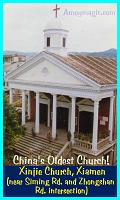 1st
Church of China
(Xinjie Libaitang) Every two-horse-town in America has a First Baptist
or a First Methodist, but there is only one First Church of China –
right in Xiamen! China’s oldest Protestant church, XinJie Church
was built in 1848 at # 29 Tai Guang Street, which is now at the corner
of Zhongshan Rd. and Siming Rd. Phone: (0592) 207-2383. Note the plaque
on the front of the church. It says "First Church in China."
Authors of a pictorial on Western religious architecture stated that this
showed how arrogant the church members were because they boasted of being
the most important church in China! I would have thought people writing
a book on Western churches would have researched their sources a little
better. I wrote them about it, but they never responded!
1st
Church of China
(Xinjie Libaitang) Every two-horse-town in America has a First Baptist
or a First Methodist, but there is only one First Church of China –
right in Xiamen! China’s oldest Protestant church, XinJie Church
was built in 1848 at # 29 Tai Guang Street, which is now at the corner
of Zhongshan Rd. and Siming Rd. Phone: (0592) 207-2383. Note the plaque
on the front of the church. It says "First Church in China."
Authors of a pictorial on Western religious architecture stated that this
showed how arrogant the church members were because they boasted of being
the most important church in China! I would have thought people writing
a book on Western churches would have researched their sources a little
better. I wrote them about it, but they never responded!
The same year that Xinjie was built, 1848, saw the first two Chinese to
be baptized—a maker of silk flowers, in his sixties, and his son.
Back to top

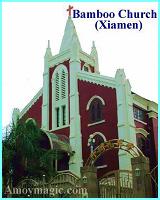 The Bamboo Church,
built in 1859, is just off the harbor near the intersection of
XiaHe Rd and Lujiang Rd. (the road that runs along the harbor, past the
Gulangyu ferry). The church has been beautifully restored, and I hear
they have a great music program on Sundays.
The Bamboo Church,
built in 1859, is just off the harbor near the intersection of
XiaHe Rd and Lujiang Rd. (the road that runs along the harbor, past the
Gulangyu ferry). The church has been beautifully restored, and I hear
they have a great music program on Sundays.
Bamboo Church Website
Click Here to Read About John Sung -- considered by many to be the 20th century's greatest evangelist (topping even Billy Sunday and Billy Graham!).
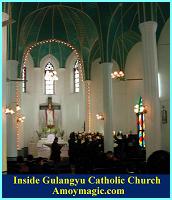
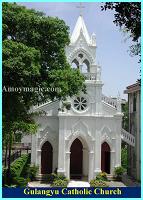
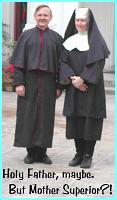 The
Catholic church on Gulangyu Island
has English services. Check out the intricately arched green wooden ceilings!
Sue and I once acted in a Sino-Japanese TV series filmed here (Sue played
a Mother Superior and I played a Holy Father!). But the nuns in the church
were furious about the camera equipment set up in the sanctuary. They
said it was irreverent.
The
Catholic church on Gulangyu Island
has English services. Check out the intricately arched green wooden ceilings!
Sue and I once acted in a Sino-Japanese TV series filmed here (Sue played
a Mother Superior and I played a Holy Father!). But the nuns in the church
were furious about the camera equipment set up in the sanctuary. They
said it was irreverent.
Gulangyu's
Trinity Church
(Protestant Church) is packed out each Sunday, and their annual Christmas
music programs are popular with Christians and nonChristians alike. Now
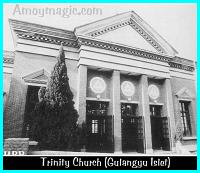 that
Gulangyu will be turned into a tourist resort, they are considering relocating
to Xiamen Island, possibly on the Island Ring Road, near Zeng Cuo'an Village.
A pity to give up their historical location--but more practical in the
long run.
that
Gulangyu will be turned into a tourist resort, they are considering relocating
to Xiamen Island, possibly on the Island Ring Road, near Zeng Cuo'an Village.
A pity to give up their historical location--but more practical in the
long run. 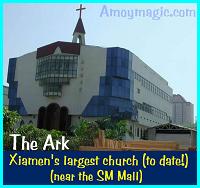
The Ark! Jiangtou District,
near SM Mart, has Xiamen's largest church--the Good News Church. This
10 million Yuan edifice looks like Frank Lloyd Wright’s version
of Noah’s Ark. But the architect should have taken some advice from
Noah, because this ark is sinking! It once stood proud and tall in an
empty field, but now is slowly submerging in a rising sea of skyscrapers.
Taller cross, perhaps? With 3,000 in attendance on Sundays, it’s
almost standing room only, so get there early (take the #7 bus from the
train station). Xiamen even has a 7th Day Adventist Church! (off Zhongshan
Rd., near the #7market).
Back to top
 Fujian
Churches
(click here for photos!) Fujian has churches,
old and new, all over the province. In fact, I've seen so many scattered
around the mountains and valleys that it reminds me of an oriental New
England.
Fujian
Churches
(click here for photos!) Fujian has churches,
old and new, all over the province. In fact, I've seen so many scattered
around the mountains and valleys that it reminds me of an oriental New
England.
Quanzhou
alone has 173 registered churches! Click here
to see photos of churches from Quanzhou and other places around the
province, as well as photos of some of the many Christian activities (Christmas
programs, pastor retreats, youth fellowships, etc.).
And now, just for fun....
Pew
Perils
Xiamen church pews are packed on Easter and Christmas, when even the Buddhists
enjoy the choirs’ special music. Get there half an hour early for
a good seat. At Christmas especially, the time will pass quickly as you
listen to recordings of such classic holiday hymns as Silent Night, The
First Noel, Frosty the Snowman and Jingle Bells. (They fit right in with
the “Santa Bless You” Christmas cards sold in book stores.)
 Do get there early! Otherwise, Laowai-loving ushers will oust some 90
year old granny from her front row pew so the foreign friend can see the
service better, and so everyone else can see the foreign friend better.
Of course, you can always gallantly refuse the granny’s seat and
perch on a red plastic stool on the front porch. But then you’re
a sitting duck for that sect which believes ‘speaking in tongues’
means mastering English. They’ll grab a stool and pull it up beside
you and spend the entire hour, nonstop, practicing English. I’ve
actually had prayers go like this:
Do get there early! Otherwise, Laowai-loving ushers will oust some 90
year old granny from her front row pew so the foreign friend can see the
service better, and so everyone else can see the foreign friend better.
Of course, you can always gallantly refuse the granny’s seat and
perch on a red plastic stool on the front porch. But then you’re
a sitting duck for that sect which believes ‘speaking in tongues’
means mastering English. They’ll grab a stool and pull it up beside
you and spend the entire hour, nonstop, practicing English. I’ve
actually had prayers go like this:
“Our Father who art in –”
“—What country are you from?”
“Thy kingdom come, thy will be –”
“—Where do you work?”
“Give us this day our –”
“—How much money do you make?”
“And lead us not into temptation.”
Like murder!
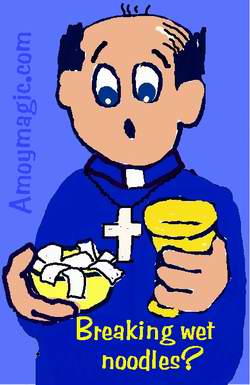 Chinese
Communion…
For 2000 years, Western Christians have ‘broken bread ’ together
during Communion. But what about those folk who don’t have bread
to break?
Chinese
Communion…
For 2000 years, Western Christians have ‘broken bread ’ together
during Communion. But what about those folk who don’t have bread
to break?
When we first came to Xiamen, Christians celebrated communion with little
squares of noodles. I liked the chewy texture, and the Chinese wine did
more for you than the grape juice we sip back home (though I learned why
communion cups are so tiny; enough of that wine and you’re in the
spirits, not in the Spirit).
Alas, Xiamen has modernized, and that includes churches. Now they use
the round, flat imported bona fide communion wafers that look and taste
like Styrofoam. Granted, they look nice, with the little cross stamped
on them. It would be tough stamping crosses on wet noodles. Still, I kind
of miss the noodles.
Back to top
Laowai 3rd Degree
In 1990, an American complained, “I’m tired of nosy Chinese!
They ask me almost non-stop, ‘Going to work?’ ‘Coming
home?’ ‘Going shopping?’ ‘Eaten yet?’”
I looked about furtively, then whispered, “Do you know why they
ask Laowai so many questions?”
He looked surprised, and whispered back, “No. Why?”
“Because they’re Communists, and they have to report on us.”
“Really?” His eyes widened as paranoia took a toehold.
“Not really!” I said, laughing. “That’s just how
Chinese greet one another!”
Westerners usually greet one another with a simple and non-invasive “Hello”
or “Good Morning” or “Nice weather today!” But
not the Chinese. They are seldom content with “Ni Hao” (How
are you?) or “Zao Shang Hao” (Good morning). Rather, they
ask what you are doing. And unlike Americans, who don’t want an
honest answer to “How are you?” Chinese do expect an answer.
I’ve never asked anyone how much money they make. I don’t
even know my own sister’s salary. But Chinese have no qualms homing
in on a strange Laowai and firing off in rapid order the Laowai 3rd Degree:
1)
“Hello, what is your name?” 2) “Where are you from?”
3) “Is it cold in America?” 4) “Where do you work?”
5) “How much do you earn?” 6) “Will you teach me English?”
It’s
culture, not nosiness. But with 1.3 billion Laonei pitted against a handful
of Laowai, it gets to you sometimes...
Back to top
Laowai
Radar
I was standing armpit to sweaty armpit on a hot bus when it screeched
to a halt to let on a youth. He still had one foot in the door when his
Laowai Radar picked me out of the crowd. With an ear-to-ear grin and eyes
nailed to me as if I were the Holy Grail (or the Worshipful Wok), he wormed
his way towards me, the Laowai 3rd Degree on the tip of his tongue. As
he sidled up under my arm and opened his mouth I preempted him with, “I’m
Pan Wei Lian from America, which is like China. Hot in the south, cold
in the north. I work in Xiamen University, and earn enough to pay taxes
but not enough to avoid them. Have I missed anything?”
So much for Sino-American friendship. His jaw dropped, he slunk away,
I felt like a cad, and I have regretted it ever since.
The Solution! Nowadays I just answer the questions, with a smile.
But I have a solution! Make life easier for Laowai and Laonei alike by
just printing the answers to the Laowai 3rd Degree on the back of your
business cards, and keep a stack at all times. But even though Chinese
have no qualms in asking “personal” questions, they also have
no aversion to answering them. In a way, their candor is refreshing, and
we Laowai could learn from it. But not in Church, please!
Back to top
The Amoy People In August 1889,
the missionary John Macgowan published his “The Story of the Amoy
Mission” in London. I marvel at how he captured the heart and soul
of the Amoy people, whom he so clearly admired. He wrote frankly of the
poverty and problems, and of the problems between Laowai and Laonei, but
he also brought to life the Amoy people’s passion and drive and,
above all, their “English sense of fair play.” So rather than
subject you to my own impoverished prose, here is a selection from his
marvellous memoir!
"Chinese stare at the foreigner, sometimes with skepticism or even thinly veiled contempt, but once they know you, “The crowd becomes sympathetic. The sneer dies out of their faces. There is nothing that touches the Chinese heart so mightily as practical benevolence. It is a virtue they highly appreciate. Their stolid, emotionless features begin to light up with genuine feeling, and the eyes of some are twinkling and flashing as their hearts are moved…[what] has just happened has been a mighty revelation. It has brought you closer to the Chinese heart than you were before, and it has revealed to you the wondrous possibilities of the future…”
“The Amoy people… are sturdy representatives of their race….They are very fiery and passionate when any injustice or wrong is attempted, but generally they are fair-minded and amenable to reason. They have an Englishman’s sense of fair play, and they have an intense respect for virtue and goodness of every kind, and they will pay devout homage to any one in whose lives these are conspicuous.”
Back to top
Rev.
Carstairs Douglas
The Man Who Opened Amoy Dialect for Westerners
Rev. Carstairs Douglas, who did more for Westerner’s understanding of the Minnan Dialect than perhaps any other man, was in excellent health one day and dead of virulent cholera the next. Talmadge, an Amoy missioanry, wrote of Douglas,
“By overwork he had worn himself out, and made himself an old man while he was yet comparatively young in years. He came to China quite young and at the time of his death was only about forty-six years of age, and yet men who had recently become acquainted with him thought him over sixty… he did more work during the twenty-two years of his missionary life than the most of men accomplish in twice that time…”
“Recently, especially during the last year, it was manifest, at least to others, that his physical strength was fast giving way. Yet he could not be prevailed upon to leave his field for a season for temporary rest, or even to lessen the amount of his work.
“I never knew a more incessant worker. He was a man of most extensive general information. I think I have never met with his equal in this respect. He was acquainted with several modern European languages and was a thorough student of the original languages of Holy Scripture, as witness the fact of his study of the Hebrew Bible, even after his last sickness had commenced. As regards the Chinese language, he was already taking his place among the first sinologues of the land.”
Back to top
Nestorian Translation The Nestorians were a millennium ahead of their time in not just medical work but also translating skills. They worked tirelessly to translate the gospel into other languages, and knew enough to avoid a word-for-word translation. They sought to capture the spirit and emotion of the texts, paraphrasing when necessary. In Chinese, the "Holy Spirit" became the "Pure Wind," and Christ's resurrection became the "Holy Transformation." Where Taoists speak of "The Way" (the literal meaning of "Tao"), Nestorians also spoke of "The Way," deliberately evoking the ideas of Taoism. But by the 9th century they had gone too far, and the Sutra of Mysterious Peace and Joy had pretty much lost all Christian content. It speaks of Christ sharing divine mysteries with the disciples who surrounded him, and after his lectures they were joyful and withdrew ceremoniously. As for the content of the "sermon on the mount?" This sutra had Christ giving a Buddhist-like sermon on overcoming desire to obtain inner joy and peace!
While Buddhism thrived because of syncretism (offering something for everyone) the same strategy helped spell the end of Nestorian Christianity in China.
Back to topDavid Abeel--Amoy's 1st Missionary
David Abeel was born in New Brunswick, New Jersey, 12 June, 1804, and died in Albany, New York, 4 September, 1846. He was educated at Rutgers College, New Brunswick, New Jersey, and studied at the Theological Seminary of the Reformed church in that place. He first pastored in Athens, New York, for two years, then sailed to Canton, China, in October, 1829, as part of the Seaman's Friend Society. A year later, he transferred to the American Board of Commissioners for Foreign Missions, and visited Java, Singapore, and Siam. He studied Chinese, but his health gave way (and no wonder; Chinese language study could do anyone in!), and he returned home via Europe in 1833. As he passed through Switzerland, France, Holland and other countries, he urged Westerners to be concerned about the gospel reaching other nations, and in England he helped found a society for promoting the education of women in Asia.
Upon his return to America, Abeel published "The Claims of the World to the Gospel," "Residence in China," and "The Missionary Convention at Jerusalem." In 1839 he visited again Malacca, Borneo, and parts of Asia, and in 1842 established a mission at Amoy, but by 1845 his health had given out and he returned home to die. In 1845 his health gave way altogether, and he returned home, where died in 1846. Two years later, Xiamen built Xinjie Church, the first Protestant Church in China.
Please
Help the "The Amoy Mission Project!" Please
share any relevant biographical material and photos for the website and
upcoming book. All text and photos will remain your property, and
photos will be imprinted to prevent unauthorized use.
Please
share any relevant biographical material and photos for the website and
upcoming book. All text and photos will remain your property, and
photos will be imprinted to prevent unauthorized use.
E-mail: amoybill@gmail.com
Snail Mail: Dr. William Brown
Box 1288 Xiamen University, Xiamen, Fujian PRC 361005
![]() Favorite
Fujian Sites
Favorite
Fujian Sites ![]() Fujian
Foto Album
Fujian
Foto Album ![]() Xiamen
Xiamen
![]() Gulangyu
Gulangyu
![]() Fujian
Guides
Fujian
Guides ![]() Quanzhou
Quanzhou
![]() Zhangzhou
Zhangzhou
![]() Longyan
Longyan
![]() Wuyi
Mtn
Wuyi
Mtn ![]() Ningde
Ningde
![]() Putian
Putian
![]() Sanming
Sanming
![]() Zhouning
Zhouning
![]() Taimu
Mtn.
Taimu
Mtn. ![]() Roundhouses
Roundhouses
![]() Bridges
Bridges
![]() Jiangxi
Jiangxi
![]() Guilin
Guilin
![]() Order
Books
Order
Books![]() Readers'
Letters New: Amoy
Vampires! Google
Search
Readers'
Letters New: Amoy
Vampires! Google
Search
Last Updated: October 2007
AMOY
MISSION LINKS
![]()
![]() A.M.
Main Menu
A.M.
Main Menu
![]() RCA
Miss'ry List.
RCA
Miss'ry List.
![]() AmoyMission-1877
AmoyMission-1877
![]() Abeel,
David
Abeel,
David
![]() Burns,
Wm.
Burns,
Wm.
![]() Develder,
Wally
Develder,
Wally
![]() Wally's
Memoirs!
Wally's
Memoirs!
![]() Douglas,
Carstairs
Douglas,
Carstairs
![]() Doty,
Elihu
Doty,
Elihu
![]() Duryea,
Wm. Rankin
Duryea,
Wm. Rankin
![]() Esther,Joe
& Marion
Esther,Joe
& Marion
![]() Hills,Jack
& Joann
Hills,Jack
& Joann
. ![]() Hill's
Photos.80+
Hill's
Photos.80+
..![]() Keith
H.
Keith
H.![]() Homeschool
Homeschool
![]() Holleman,
M.D.
Holleman,
M.D.
![]() Johnston
Bio
Johnston
Bio
![]() Karsen,
W&R
Karsen,
W&R
![]() Kip,
Leonard W.
Kip,
Leonard W.
![]() Meer
Wm. Vander
Meer
Wm. Vander
![]() Muilenbergs
Muilenbergs
![]() Oltman,
M.D.
Oltman,
M.D.
![]() Otte,M.D.
Otte,M.D.![]() Last
Days
Last
Days
![]() Poppen,
H.& D.
Poppen,
H.& D.
![]() Talmage,
J.V.N.
Talmage,
J.V.N.
![]() Veenschotens
Veenschotens
. ![]() Henry
V.
Henry
V.![]() Stella
V.
Stella
V.
. ![]() Girard
V.
Girard
V.
![]() Warnshuis,
A.L.
Warnshuis,
A.L.
![]() Fuh-chau
Cemetery
Fuh-chau
Cemetery
![]() City
of Springs
City
of Springs
(Quanzhou, 1902!!)
![]() XM
Churches
XM
Churches ![]()
![]() Church
History
Church
History ![]()
![]() Opium
Wars
Opium
Wars
![]() A.M.
Bibliography
A.M.
Bibliography
![]() YMCA
Volunteer!
YMCA
Volunteer!
![]() XICF
Fellowship
XICF
Fellowship![]()
![]() Temples
Temples![]()
![]() Mosques
Mosques
![]() Christ
in Chinese
Christ
in Chinese
Artists'
Eyes
DAILY LINKS
![]() FAQs
Questions?
FAQs
Questions?
![]() Real
Estate
Real
Estate
![]() Shopping
Shopping
![]() Maps
Maps
![]() Bookstores
Bookstores
![]() Trains
Trains
![]() Busses
Busses
![]() Car
Rental
Car
Rental
![]() Hotels
Hotels
![]() News
(CT)
News
(CT)
![]() Medical
& Dental
Medical
& Dental
![]() Expat
Groups
Expat
Groups
![]() Maids
Maids
![]() Phone
#s
Phone
#s
EDUCATION
![]() Xiamen
University
Xiamen
University
![]() XIS(Int'l
School)
XIS(Int'l
School)
![]() Study
Mandarin
Study
Mandarin
![]() CSP(China
Studies)
CSP(China
Studies)
![]() Library
Library
![]() Museums
Museums
![]() History
History
DINING ![]() Tea
Houses
Tea
Houses
![]() Restaurants
Restaurants
![]() Asian
Asian
![]() Veggie
Veggie
![]() Junk
Food
Junk
Food
![]() Chinese
Chinese
![]() Italian
Italian
![]() International
International![]()
![]() Visas
4 aliens
Visas
4 aliens
RECREATION
![]() Massage!
Massage!
![]() Beaches
Beaches
![]() Fly
Kites
Fly
Kites
![]() Sports
Sports
![]() Boardwalk
Boardwalk
![]() Parks
Parks
![]() Pets
Pets
![]() Birdwatching
Birdwatching
![]() Kung
Fu
Kung
Fu ![]() Hiking
Hiking
![]() Music
Events
Music
Events
![]() Cinema
Cinema
![]() Festival&Culture
Festival&Culture
![]() Humor&
Humor&![]() Fun
Fotos
Fun
Fotos![]()
BUSINESS
![]() Doing
Business
Doing
Business
![]() Jobs!(teach/work)
Jobs!(teach/work)
![]() Hire
Workers
Hire
Workers
![]() Foreign
Companies
Foreign
Companies
![]() CIFIT
(Trade Fair)
CIFIT
(Trade Fair)
![]() MTS(Translation)
MTS(Translation)
![]()
Back to Top
